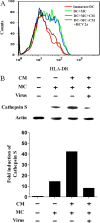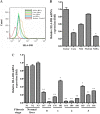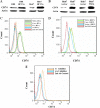Hepatitis C virus-mediated inhibition of cathepsin S increases invariant-chain expression on hepatocyte surface
- PMID: 22761382
- PMCID: PMC3446550
- DOI: 10.1128/JVI.00388-12
Hepatitis C virus-mediated inhibition of cathepsin S increases invariant-chain expression on hepatocyte surface
Abstract
Hepatocytes are the main source of hepatitis C virus (HCV) replication and contain the maximum viral load in an infected person. Chronic HCV infection is characterized by weak cellular immune responses to viral proteins. Cathepsin S is a lysosomal cysteine protease and controls HLA-DR-antigen complex presentation through the degradation of the invariant chain. In this study, we examined the effect of HCV proteins on cathepsin S expression and found it to be markedly decreased in dendritic cells (DCs) exposed to HCV or in hepatocytes expressing HCV proteins. The downregulation of cathepsin S was mediated by HCV core and NS5A proteins involving inhibition of the transcription factors interferon regulatory factor 1 (IRF-1) and upstream stimulatory factor 1 (USF-1) in gamma interferon (IFN-γ)-treated hepatocytes. Inhibition of cathepsin S by HCV proteins increased cell surface expression of the invariant chain. In addition, hepatocytes stably transfected with HCV core or NS5A inhibited HLA-DR expression. Together, these results suggested that HCV has an inhibitory role on cathepsin S-mediated major histocompatibility complex (MHC) class II maturation, which may contribute to weak immunogenicity of viral antigens in chronically infected humans.
Figures





Similar articles
-
Hepatitis C virus inhibits cell surface expression of HLA-DR, prevents dendritic cell maturation, and induces interleukin-10 production.J Virol. 2008 Apr;82(7):3320-8. doi: 10.1128/JVI.02547-07. Epub 2008 Jan 23. J Virol. 2008. PMID: 18216090 Free PMC article.
-
Human dendritic cells expressing hepatitis C virus core protein display transcriptional and functional changes consistent with maturation.J Viral Hepat. 2011 Oct;18(10):700-13. doi: 10.1111/j.1365-2893.2010.01357.x. Epub 2010 Aug 4. J Viral Hepat. 2011. PMID: 20701679
-
Hepatitis C virus attenuates interferon-induced major histocompatibility complex class I expression and decreases CD8+ T cell effector functions.Gastroenterology. 2014 May;146(5):1351-60.e1-4. doi: 10.1053/j.gastro.2014.01.054. Epub 2014 Jan 31. Gastroenterology. 2014. PMID: 24486950 Free PMC article.
-
Interferon alpha (IFNα)-induced TRIM22 interrupts HCV replication by ubiquitinating NS5A.Cell Mol Immunol. 2016 Jan;13(1):94-102. doi: 10.1038/cmi.2014.131. Epub 2015 Feb 16. Cell Mol Immunol. 2016. PMID: 25683609 Free PMC article.
-
Understanding the molecular mechanism(s) of hepatitis C virus (HCV) induced interferon resistance.Infect Genet Evol. 2013 Oct;19:113-9. doi: 10.1016/j.meegid.2013.06.025. Epub 2013 Jul 5. Infect Genet Evol. 2013. PMID: 23831932 Review.
Cited by
-
The Key Role of Lysosomal Protease Cathepsins in Viral Infections.Int J Mol Sci. 2022 Aug 13;23(16):9089. doi: 10.3390/ijms23169089. Int J Mol Sci. 2022. PMID: 36012353 Free PMC article. Review.
-
Cathepsin S: molecular mechanisms in inflammatory and immunological processes.Front Immunol. 2025 Jul 7;16:1600206. doi: 10.3389/fimmu.2025.1600206. eCollection 2025. Front Immunol. 2025. PMID: 40692794 Free PMC article. Review.
-
ZIKV Infection Induces DNA Damage Response and Alters the Proteome of Gastrointestinal Cells.Viruses. 2020 Jul 17;12(7):771. doi: 10.3390/v12070771. Viruses. 2020. PMID: 32708879 Free PMC article.
-
Depletion of MicroRNA-373 Represses the Replication of Hepatitis C Virus via Activation of Type 1 Interferon Response by Targeting IRF5.Yonsei Med J. 2018 Dec;59(10):1181-1189. doi: 10.3349/ymj.2018.59.10.1181. Yonsei Med J. 2018. PMID: 30450852 Free PMC article.
-
Contribution of autophagy to antiviral immunity.FEBS Lett. 2015 Nov 14;589(22):3461-70. doi: 10.1016/j.febslet.2015.07.047. Epub 2015 Aug 20. FEBS Lett. 2015. PMID: 26297829 Free PMC article. Review.
References
-
- Auffermann-Gretzinger S, Keeffe EB, Levy S. 2001. Impaired dendritic cell maturation in patients with chronic, but not resolved, hepatitis C virus infection. Blood 97:3171–3176 - PubMed
-
- Bain C, et al. 2001. Impaired allostimulatory function of dendritic cells in chronic hepatitis C infection. Gastroenterology 120:512–524 - PubMed
Publication types
MeSH terms
Substances
Grants and funding
LinkOut - more resources
Full Text Sources
Research Materials

